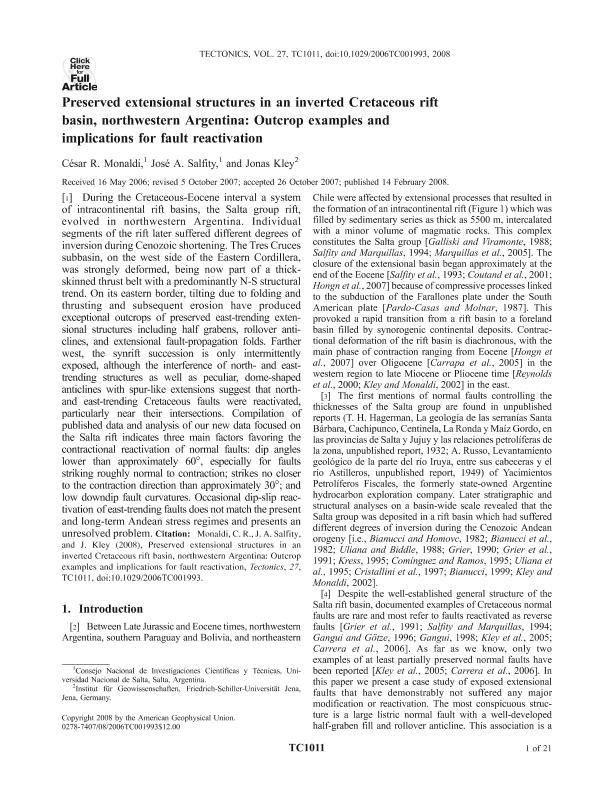Mostrar el registro sencillo del ítem
dc.contributor.author
Monaldi, Cesar Ruben

dc.contributor.author
Salfity, Jose Antonio

dc.contributor.author
Kley, Jonas
dc.date.available
2019-04-08T21:33:00Z
dc.date.issued
2008-02-14
dc.identifier.citation
Monaldi, Cesar Ruben; Salfity, Jose Antonio; Kley, Jonas; Preserved extensional structures in an inverted Cretaceous rift basin, northwestern Argentina: Outcrop examples and implications for fault reactivation; American Geophysical Union; Tectonics; 27; 1; 14-2-2008; 1-21
dc.identifier.issn
0278-7407
dc.identifier.uri
http://hdl.handle.net/11336/73521
dc.description.abstract
During the Cretaceous-Eocene interval a system of intracontinental rift basins, the Salta group rift, evolved in northwestern Argentina. Individual segments of the rift later suffered different degrees of inversion during Cenozoic shortening. The Tres Cruces subbasin, on the west side of the Eastern Cordillera, was strongly deformed, being now part of a thick-skinned thrust belt with a predominantly N-S structural trend. On its eastern border, tilting due to folding and thrusting and subsequent erosion have produced exceptional outcrops of preserved east-trending extensional structures including half grabens, rollover anticlines, and extensional fault-propagation folds. Farther west, the synrift succession is only intermittently exposed, although the interference of north- and east-trending structures as well as peculiar, dome-shaped anticlines with spur-like extensions suggest that north-and east-trending Cretaceous faults were reactivated, particularly near their intersections. Compilation of published data and analysis of our new data focused on the Salta rift indicates three main factors favoring the contractional reactivation of normal faults: dip angles lower than approximately 60°, especially for faults striking roughly normal to contraction; strikes no closer to the contraction direction than approximately 30°; and low downdip fault curvatures. Occasional dip-slip reactivation of east-trending faults does not match the present and long-term Andean stress regimes and presents an unresolved problem.
dc.format
application/pdf
dc.language.iso
eng
dc.publisher
American Geophysical Union

dc.rights
info:eu-repo/semantics/openAccess
dc.rights.uri
https://creativecommons.org/licenses/by-nc-sa/2.5/ar/
dc.subject
Extensional Structures
dc.subject
Cretaceous
dc.subject
Rift Basin
dc.subject
Fault Reactivation
dc.subject.classification
Geoquímica y Geofísica

dc.subject.classification
Ciencias de la Tierra y relacionadas con el Medio Ambiente

dc.subject.classification
CIENCIAS NATURALES Y EXACTAS

dc.title
Preserved extensional structures in an inverted Cretaceous rift basin, northwestern Argentina: Outcrop examples and implications for fault reactivation
dc.type
info:eu-repo/semantics/article
dc.type
info:ar-repo/semantics/artículo
dc.type
info:eu-repo/semantics/publishedVersion
dc.date.updated
2019-03-26T20:35:38Z
dc.journal.volume
27
dc.journal.number
1
dc.journal.pagination
1-21
dc.journal.pais
Estados Unidos

dc.journal.ciudad
Washington
dc.description.fil
Fil: Monaldi, Cesar Ruben. Consejo Nacional de Investigaciones Científicas y Técnicas; Argentina. Universidad Nacional de Salta; Argentina
dc.description.fil
Fil: Salfity, Jose Antonio. Consejo Nacional de Investigaciones Científicas y Técnicas; Argentina. Universidad Nacional de Salta; Argentina
dc.description.fil
Fil: Kley, Jonas. Universitat Jena; Alemania
dc.journal.title
Tectonics

dc.relation.alternativeid
info:eu-repo/semantics/altIdentifier/doi/http://dx.doi.org/10.1029/2006TC001993
dc.relation.alternativeid
info:eu-repo/semantics/altIdentifier/url/https://agupubs.onlinelibrary.wiley.com/doi/full/10.1029/2006TC001993
Archivos asociados
